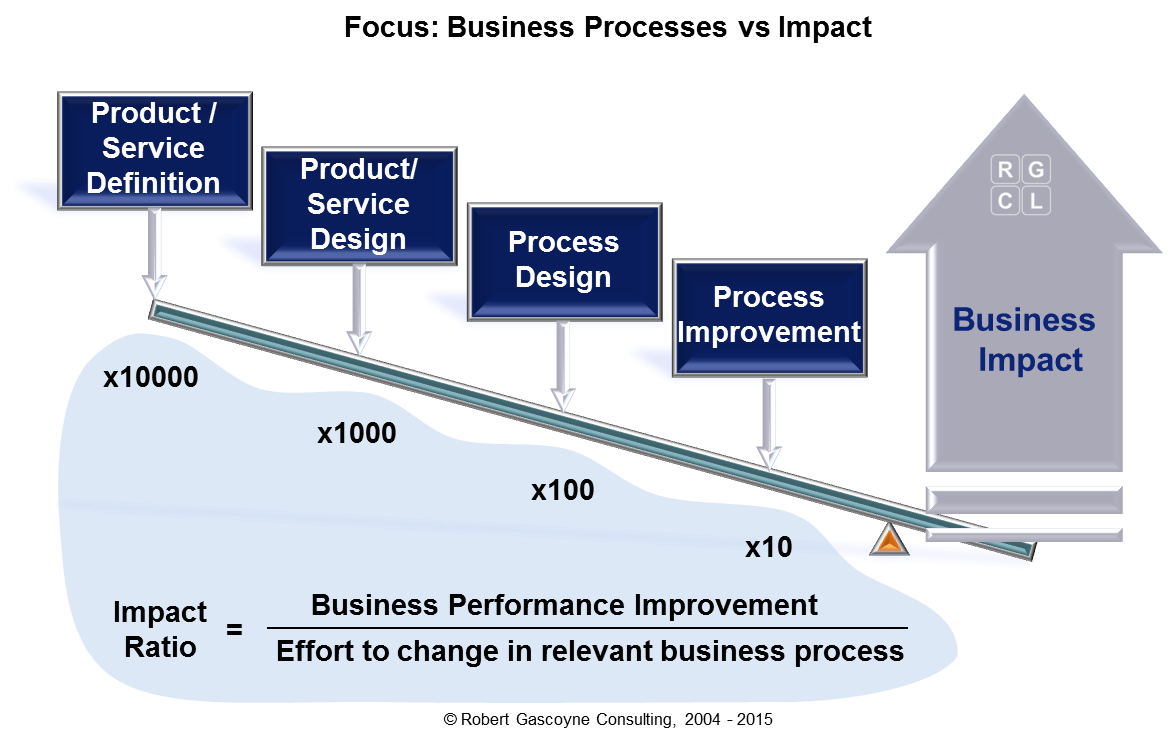
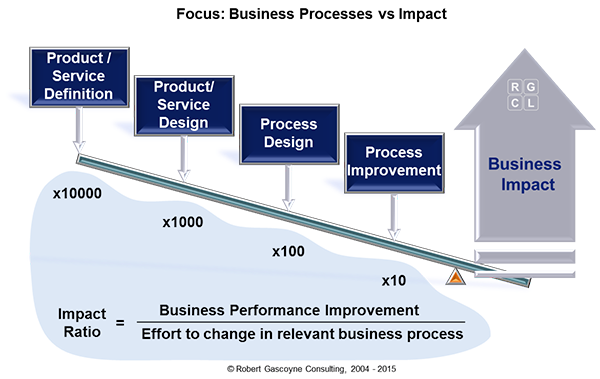
Imagine designing a new product, service, or process that didn’t need improvement projects to make it perform to the required level. That’s what Design for Six Sigma is about - an efficient design process, ensuring that your new product, service, or process has excellent performance from day one.
It is generally considered that focussing on process improvement provides a ten-fold payback relative to the effort put in. However, if the processes had been designed perfectly, the benefit would be ten times greater still. The previous stage in the business value chain is Product or Service design, where changes may have radical impact on the processes (nominally, ten times the impact again). Lastly, the definition of the product has the largest potential impact as it governs the design. Impacting these early phases provides more than performance improvement, it drives business transformation.
What is Design for Six Sigma (DFSS)?
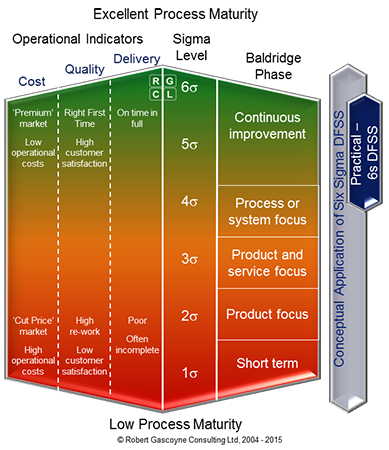
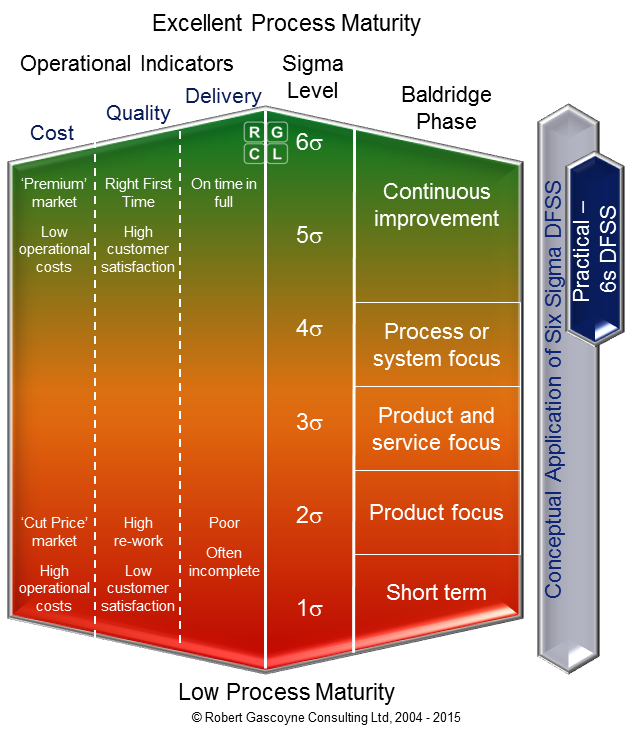
- The Design for Six Sigma, or ‘DFSS’, methodology addresses Product / Service definition through the design phases to delivery of the operational products, services and processes that deliver them
- Six Sigma (6σ) derives its name from its statistical performance target, which equates to 99.99966% good (or just 3.4 PPM defects)
- Six Sigma achieves these incredible quality levels by:
- Focussing on customer alignment of functions, features and processes
- On establishing clear linkages and customer goals, variation from the goals is identified
- Causes are identified, prioritised and eliminated and/or controlled
- The result is virtually defect free parts, products, services and processes
- Six Sigma DFSS is a rigorous, ‘heavyweight’ process, requiring a high level of training, coaching and support to become proficient
- Six Sigma practitioners are generally known as ‘Green Belts’ and ‘Black Belts’. They are coached by ‘Master Black Belts’ and supported by management ‘Champions’
- The personal development and subsequent career progression of Six Sigma practitioners is usually linked to becoming ‘certified’ at each level. Certification is dependant on having met a set of stringent, pre-defined criteria, including: education, experience, and proof of results through deploying the Six Sigma methodology and tools
- Unlike DMAIC, DFSS has several commonly used roadmaps, including:
- DMADV
- DMEDI
- IDOV
- ICOV
- We use and endorse all of these, which are selected by client preference or organisational fit of the roadmap
Why we get results
- We have substantial experience in training, coaching and deploying Design for Six Sigma
- We can help you specify the best approach for your business (see Diagnostics for more details), or simply provide whatever consultancy, training and coaching or development you require
- We’re practical and pragmatic - our focus is always on getting results (we’re practitioners - not just trainers!)
- We tailor our services and approach to meet your needs (please see methodology deployment requirements diagram below)
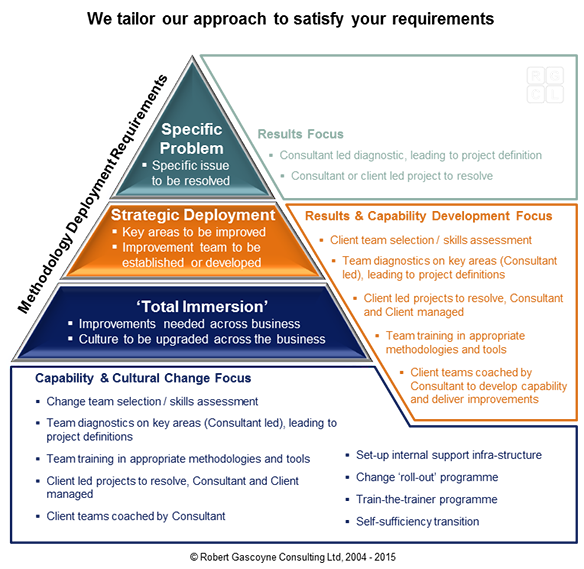
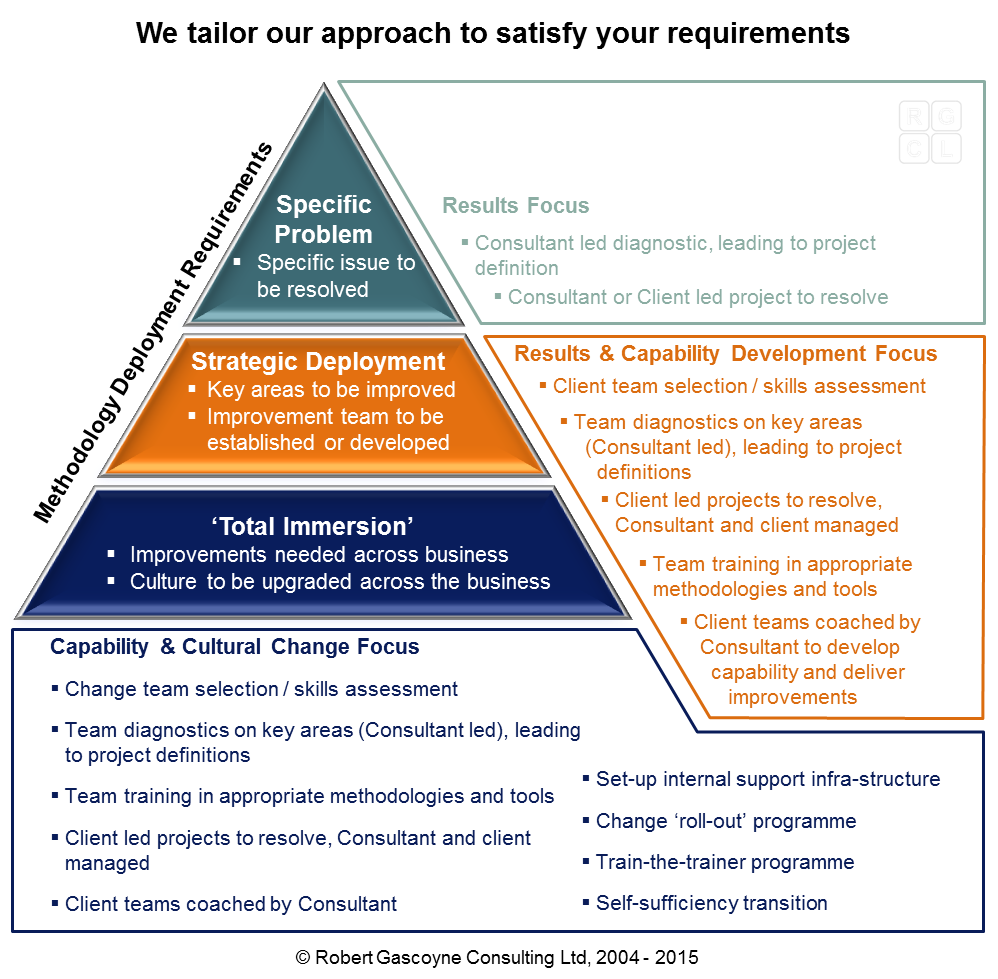
There are three basic levels to deploy any methodology:
- At a basic level a methodology can be used to solve a specific problem
- Methodologies can also be deployed strategically to resolve strategic issues across the business. Generally, this involves developing capability within the business to achieve this
- Often, businesses decide to apply a uniform approach to business improvement across their entire business. This, ‘total immersion’ approach, involves developing a ‘critical mass’ of capability within the company, with support structures to ensure that it is self-sustaining
- We can help you, whatever deployment model you choose - please contact us to discuss your requirements
Capability Development
The level of capability development is an important factor in Strategic and ‘Total Immersion’ deployments
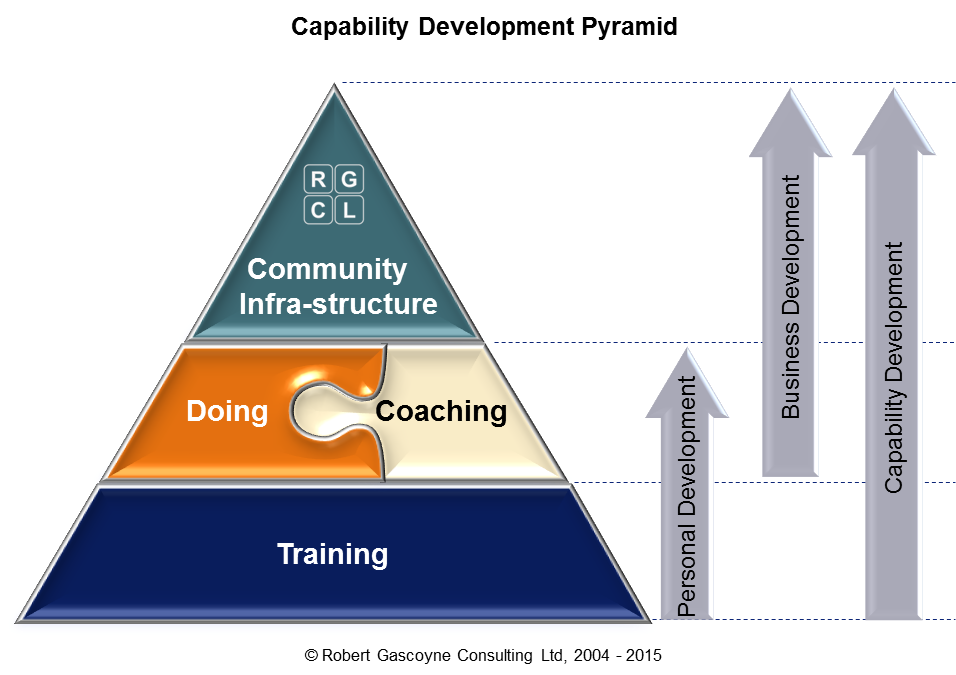
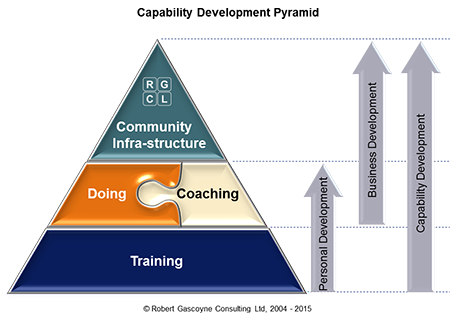
- Training provides knowledge, but real understanding is only developed by doing
- We offer a range of coaching services, to guide capability development and ensure that results are achieved.
- Beyond having people that can do, you’ll need your own, sustainable, support structure to ensure the continued growth and success of your capability - we’ll help you create, or develop, your infra-structure to achieve this
Training, Coaching & Support
Besides full deployments, we also offer the individual components, to support and supplement existing programmes:
- Six Sigma training: bespoke and 'off-the-shelf' DFSS courses available:
- Awareness
- Champion
- Green Belt
- Black Belt
- Master Black Belt, including 'train the trainer'
- For more general information about training please click [link to Training page]
- Six Sigma coaching:
- A range bespoke of support options to ensure that both personal capability and business results are achieved. These range from providing a full-time support team to remote support options, as appropriate
- Coaching is especially important for Six Sigma, as it is a ‘heavy-weight’ methodology and can be abstract for anyone not familiar with statistical analysis. It is therefore essential to safeguard your investment in training by ensuring that the trainees have adequate support during their early projects
- For more general information about coaching please click [link to Coaching page]
- Six Sigma Accreditation, or certification, of Six Sigma professionals requires that they have proven their skills and understanding by successfully delivering projects using the methodology
- We provide certification at all levels
- When you have sufficient internal capability, we can also design, develop and install your own corporate certification process, ensuring that the capability you're developing continues to meet the real needs of your business.
- Six Sigma community infra-structure: Bespoke services to design, develop and install appropriate capability support and development infra-structure.
Imagine your future products and processes without today's problems…
Please contact us to discuss your requirements
Next Steps
We’d be glad to provide more details, or discuss your requirements with you. Please contact us
Related Tools, Techniques & Methodologies
We offer consultancy (diagnostics, project definition, projects, deployments, training and coaching in the following Six Sigma related tools, techniques and methodologies:
Basic Quality Tools
- Pareto Analysis
- Cause & Effect Diagrams (Fishbone, Ishikawa)
- Concentration Diagrams (Measles chart)
- Check Sheets
Mapping Tools
- Spaghetti Diagrams
- Process Chart
- Flowcharting
- Process Maps
- Spaghetti Diagrams
- SIPOC
- Function Trees
- IDEF0
Further Quality Tools
- FMEA Overview
- Concept / System FMEA
- Design FMEA
- Process FMEA
- QFD (Basic, 4 Houses of Quality)
- Complexity (OFD)
- Design For Assembly (DFA)
- Design For Manufacture (DFM)
- Mistake/Error Proofing (Poka Yoke)
- Cost of Poor Quality (CoQ, CoPQ)
- Taguchi Robust Design (system, parameter, tolerance)
- Tolerancing strategies
- See Design tools page
Graphical Data Analysis
- Histograms
- Boxplots
- Dotplots
- Run charts (Time series plots)
- Scatter diagrams
- Multi-Vari Charts
- Main Effects Plots
- Interaction charts
Process / Design Control
- Standard Operating Procedures (SOP)
- Out of Control Action Plans (OCAP)
- Gauge control plans
- Control Plans & planning
- Design Validation Plans (DVP)
Customer Focus
- VoC
- VoB
- Identifying Customer Needs (Focus Groups, Surveys, Affinity Diagrams, etc)
- CTQ Flowdown
- Kano Model
- Taguchi Loss Function
Basic Statistical Tools
- Basic Statistics
- Introduction to Statistical Process Control (SPC)
- Statistical Process Control (Run charts, Control Charts: X & R, X & s, np, p, c, u, etc)
- Process Capability (Cp, CpL, CpU, CpK, Pp, PpL, PpU, PpK, Zst, Zlt, PPM)
- Correlation
- Regression - Simple Linear
- Data Types (Continuous, Categorical, Poisson, Discrete, Count, Ordinal, Binomial, Attribute)
- Data Collection / Sampling Techniques
- See Statistical Tools page
Further Statistical Tools
- Central Limit Theorem
- Confidence Intervals
- Power and Sample size
- Regression - Non-linear (quadratic, cubic)
- Multiple Regression)
- Gauge R&R (Attribute, Continuous, Destructive)
- Process Capability - Non-normal (Binomial, Poisson, Weibull)
- CUSUM (+V mask)
- EWMA
- Transforming Non-normal Data (Box Cox, Johnson)
- Process Yield Calculation
- Span
- Stable Operations methodology
- See Statistical Tools page
Hypothesis testing
- Introduction to Hypothesis testing
- General tests for averages (1 sample Z test, 1 sample t-test, 2 sample t-test, paired t – test, t-test - 2 Sample, 1 proportion test, 2 proportion test)
- Tests for spread / dispersion (F-test, Levene’s test, Bartlett’s test)
- ANOVA (1 way, 2 way, Balanced, MANOVA, General Linear Model, General, Nested)
- Chi Square test
- Non-Parametric tests (1 sample Sign, 1 sample Wilcoxon, Kruskal-Wallis, Mann-Whitney, Moods Median test)
- Normality Testing (Andersen-Darling, Ryan-Joiner, Shapiro-Wilk, Komologorov-Smirnov)
- See Statistical Tools page
Design of Experiments (DoE)
- Introduction to DoE
- 2 Level - Linear DoE (Full, Fractional, Plackett-Burman, Blocking, main effects plots, interaction plots, etc)
- 3 Level - Non-linear DoE (CCD, Box Benkhen, surface and contour plots)
- Taguchi Designs
- See Statistical Tools page
Reliability
- Sequential Probability Ratio Testing (SPRT)
- MEOST
- Accelerated Life Testing (ALT)
Management
- Management Systems
- Short Interval Control (SIC)
- Project Status Reporting
- Six Sigma Roles (Champion, GB, BB, MBB)
- Project Charter
- Critical Path Analysis
- Gantt Charts
- Network Charts
- PERT Charts
- Time Management
- Mental planning models (GRPI, TSRE, OSCA)
- Building a Financial benefits & results case
- Certification Requirements
- Design Scorecards
- See Management Tools page
Tactical skills
- Change Management
- Conflict Management
- Effective Meetings
- Faces of resistance
- Facilitation
- Stakeholder analysis
- Leadership
- Team building
- See Management Tools page
Creative Tools
- Brainstorming
- TRIZ
Organisational Tools & Prioritisation
- Affinity Diagrams
- Pugh Matrix
Data Analysis
- Data Manipulation (basic, intermediate, advanced)
- Minitab™ (basic, intermediate, advanced, bespoke)
- JMP™ (basic, intermediate, advanced, bespoke)
More Tools
- See Complexity page
- See Design page
- See Product Cost Reduction page
- See Lean Six Sigma page
- See Lean page
- See Kaizen page
- See Shainin page
- See TRIZ page
- Too many to list! - Contact us
Please contact us to discuss your requirements
Minitab is a trademark of Minitab Inc.
JMP is a trademark of SAS Institute